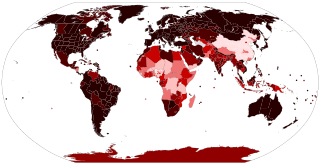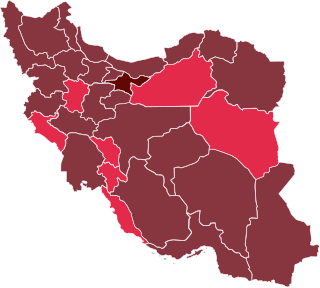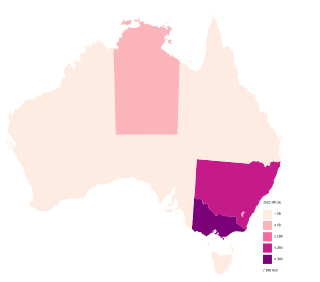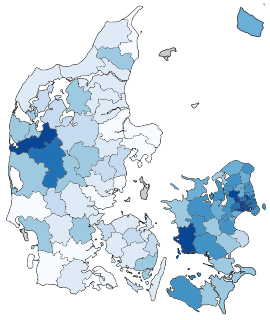
This article provides a general overview and documents the status of locations by continents and conveyance of the world affected by the coronavirus responsible for the ongoing 2019–20 pandemic originating in Wuhan, Hubei, China. It may not include all the most up-to-date major responses and measures by individual countries and territories.

An outbreak of coronavirus disease 2019 (COVID-19), part of the 2019–2020 global pandemic, has been ongoing in Thailand since 13 January 2020, when the country made the first confirmation of a case outside China. Surveillance among incoming travellers revealed a small number of cases throughout January, almost all of whom were visitors or residents returning from China. The first reported local transmission was confirmed on 31 January. The number of cases remained low throughout February, with forty confirmed by the end of the month. Cases saw a sharp increase in mid-March, which was attributed to several transmission clusters, the largest of which occurred at a Muay Thai fight at the Lumpinee Boxing Stadium on 6 March. Confirmed cases rose to over a hundred per day over the following week, and public venues and businesses were ordered to close in Bangkok and several other provinces. Prime Minister Prayut Chan-o-cha declared a state of emergency, effective on 26 March. A curfew has been announced, effective since night of 3 April 2020.

During the 2019–20 coronavirus pandemic, Iran reported its first confirmed cases of SARS-CoV-2 infections on 19 February 2020 in Qom. The virus may have been brought to the country by a merchant from Qom who had travelled to China.

As of 13 March 2020, the World Health Organization (WHO) considered Europe the active centre of the 2019–20 coronavirus pandemic. Cases by country across Europe had doubled over periods of typically 3 to 4 days, with some countries showing doubling every 2 days.

An ongoing pandemic of coronavirus disease 2019, a novel infectious disease caused by severe acute respiratory syndrome coronavirus 2, was first confirmed to have spread to Italy on 31 January 2020, when two Chinese tourists in Rome tested positive for the virus. One week later an Italian man repatriated back to Italy from the city of Wuhan, China, was hospitalised and confirmed as the third case in Italy. A cluster of cases was later detected, starting with 16 confirmed cases in Lombardy on 21 February, and 60 additional cases and the first deaths on 22 February. By the beginning of March, the virus had spread to all regions of Italy.

The first confirmed case of the pandemic of coronavirus disease 2019 (COVID-19) in the United Arab Emirates was announced on 29 January 2020. It was the first country in the Middle East to report a confirmed case. The first patient, a 73-year-old Chinese woman, was released on 9 February after recovering. The first two deaths were confirmed on March 20. On 22 March, Dubai started an 11-day sterilisation campaign as an effort to contain the coronavirus. Night curfew was imposed 4 days later while the country began disinfection. School closure was first announced on March 8 for 4 weeks. 3 weeks later, it was announced that school will be closed until the end of the academic year.

The ongoing pandemic of coronavirus disease 2019, a novel infectious disease caused by severe acute respiratory syndrome coronavirus 2, spread to Germany on 27 January 2020, when the first case was confirmed and contained near Munich, Bavaria. The majority of the cases in January and early February originated from the headquarters of a car parts manufacturer there. On 25 and 26 February, multiple cases related to the Italian outbreak were detected in Baden-Württemberg. A large cluster linked to a carnival event was formed in Heinsberg, North Rhine-Westphalia, with the first death reported on 9 March 2020. New clusters were introduced in other regions via Heinsberg as well as via people arriving from China, Iran and Italy, from where non-Germans could arrive by plane until 17–18 March.

The 2019–20 coronavirus pandemic was confirmed to have reached Australia on 25 January 2020 in Victoria, when a man returning from Wuhan, Hubei, China, was tested positive for SARS-CoV-2.

The 2019–2020 coronavirus pandemic was confirmed to have spread to Switzerland on 25 February 2020 when the first case of COVID-19 was confirmed following a COVID-19 outbreak in Italy. A 70-year-old man in the Italian-speaking canton of Ticino which borders Italy, tested positive for SARS-CoV-2. The man had previously visited Milan. Afterwards, multiple cases related to the Italy clusters were discovered in multiple cantons, including Basel-City, Zürich, and Graubünden. Multiple isolated cases not related to the Italy clusters were also subsequently confirmed.

The 2019–20 coronavirus pandemic has reached mainland Denmark. The first confirmed case of COVID-19 in Denmark was on 27 February 2020. As of 3 May 2020, there have been 9,523 confirmed cases in Denmark. Among these, 484 have died, 6,987 recovered and 243 are in hospital, including 62 in intensive care.

The 2019–20 coronavirus pandemic was confirmed to have reached Iceland in February 2020. As of 2 May 2020, the total number of cases registered is 1,799, of which 1,717 have recovered and 10 have died. With a total population of 366,130, the infection rate is 1 case per 204 inhabitants, one of the highest in the world, though this is attributed to more tests have been carried out per capita in Iceland than any other country; these include a screening of the general population run by Icelandic biotech company deCODE genetics to determine the true spread of the virus in the community.

The 2019–20 coronavirus pandemic was confirmed to have reached Liechtenstein in early March 2020. With total population of 38,749, in 29 March infection rate is 1 case per 472 inhabitants.

The 2020 coronavirus pandemic in Egypt is part of an ongoing worldwide coronavirus pandemic in which first case of COVID-19 in Egypt was confirmed on 14 February 2020. As of 1 May 2020, there have been 5,895 confirmed cases, 1,460 recoveries and 406 deaths.
The 2019–20 coronavirus pandemic was confirmed to have reached Cyprus in March 2020. The released data from the Cyprus government includes cases in the British Overseas Territory of Akrotiri and Dhekelia, but not cases in Turkish-occupied regions due to a long-running dispute.
The 2020 coronavirus pandemic in British Columbia is an ongoing 2019–20 worldwide viral pandemic of coronavirus disease 2019 (COVID-19), a novel infectious disease caused by severe acute respiratory syndrome coronavirus 2 (SARS-CoV-2). On January 28, British Columbia became the second province to confirm a case of COVID-19 in Canada. The first case of infection was reported on January 28, where the patient had recently returned from Wuhan, Hubei province, China. The first case of community transmission in Canada was confirmed in British Columbia on March 5. As of May 2, 2020, the BC Centre for Disease Control has announced 2,171 confirmed cases, 1,376 recoveries, and 114 deaths. As of April 29, 2020, 86,624 people have been tested for the virus in British Columbia.
This article outlines the 2019–20 coronavirus pandemic in the German federal state of North Rhine-Westphalia. As of April, there have been 19,384 confirmed cases, including 446 deaths.

This article provides an overview of worldwide curfews, quarantines, and similar restrictions related to the 2019–20 coronavirus pandemic and established to prevent further spread of the severe acute respiratory syndrome coronavirus 2 (SARS-CoV-2), which causes COVID-19.

A coronavirus party is a gathering, ostensibly to catch COVID-19, but sometimes just held on the basis that the participants are not worried about the consequences either personally or to the community. The phenomenon has been noted in Germany, the United States and the United Kingdom. Such gatherings are explicitly mentioned in the Netherlands model safety orders for the pandemic.

The Healthcare number 1450 - "When it hurts! 1450" - is the first point of contact for health questions in Austria. Specially trained qualified nursing staff advise callers on their health complaints.



















